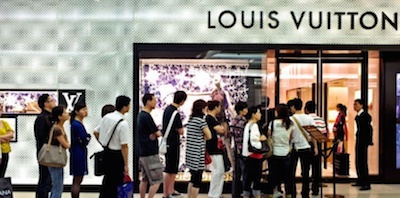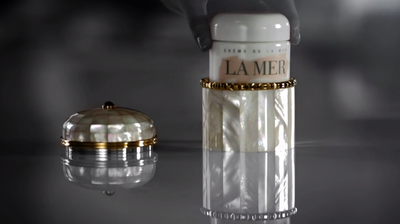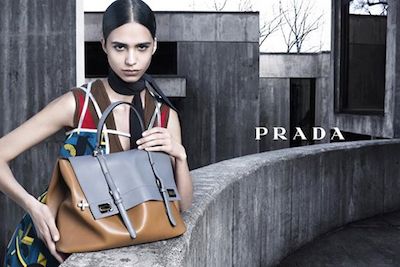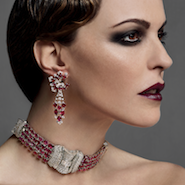The global luxury market is projected to be valued at $374.85 billion by 2020, according to a new report by Transparency Market Research.
Luxury goods are expected to experience a compound annual growth rate of 3.4 percent from 2014 to 2020. The European and United States markets are anticipated to experience a slower growth compared to the rest of the world, but Europe will remain the largest luxury market in terms of revenue.
"At present we believe that market in U.S. is bit sluggish and we believe that increasing trend towards middle class and increasing bandwidth of products with prices will help luxury goods manufacturers to sustain in U.S. market," said Gaurav Bhushan, assistant manager, consumer goods, at Transparency Market Research.
"Even economic slowdown have impacted the overall growth as per capita propensity of HNWs have decreased even though their lavish lifestyle will also support the overall market in U.S.," he said.
"Europe has a mix breed of developing as well as developed countries. Local players have dominated the market in developing regions but major players such as LVMH and Kering have targeted Scandinavia, and other untapped regions in Europe."
The “Global Industry Analysis, Size, Share, Growth, Trends and Forecast 2014 – 2020” report focuses on luxury goods, such as apparel and accessories, leather goods, jewelry and cosmetics, and excludes services, such as hotels and yachts. Transparency Market Research conducted in-depth interviews with industry leaders, including CEOs and market intelligence managers.
Strong sectors
Young affluent individuals and a boost in consumer confidence in established markets in Europe and the U.S. is expected to fuel the growth in the luxury sector over the next six years. In a number of established markets, economic conditions are improving, leading individuals to have more disposable income.
There is also a growing number of high-net-worth consumers.
Additionally, there was an increase in the combined wealth of the world’s billionaires this year, a population that is largely represented by European countries, according to a new report by Wealth-X and UBS (see story).
Tourism is also a driver of growth, as travelers from China, Brazil, Russia, South Africa and India spend money in duty free stores. Consumers from developing nations are becoming increasingly brand-conscious, and are spending on luxury overseas, where there are often smaller duties and taxes.

Chinese tourists outside of Louis Vuitton store
Hard luxury goods, including watches and jewelry, is rising the fastest out of all of the products in the sector. Currently underpenetrated in developing nations, consumers in these markets are changing their styles of dress and desiring non-traditional jewelry.
Fragrance currently has a low penetration in emerging markets, and is anticipated to see the largest growth over the next six years. Retailers such as Selfridges and Harrods are helping fragrance brands boost their sales via exclusive events and limited-edition products.

Boucheron jar for La Mer available at Harrods
North America is currently the largest market for personal care items, in terms of revenue.
More aspirational consumers in Asia and Latin America are expected to help demand for high-end spirits grow.
Even with large growth in other product categories, apparel and leather goods remains the largest segment in terms of revenue. The demand for leather goods is projected to surpass designer fashion in the future.
Africa in particular has a high growth potential for luxury fashion.
Overall, Europeans are changing their spending habits, switching their budgets from lavish goods to experiences. They have reduced their purchases of goods such as handbags from houses including Prada or Hermès.

Prada fall/winter 2014 handbag effort
Canada is expected to see a heightened demand for luxury goods as U.S. retailers expand north.
For instance, department store chain Nordstrom opened its first international store in Calgary, Alberta in Canada on Sept. 19.
The 140,000 square-foot store in Chinook Centre houses a new beauty concept and full restaurant, as well as five shoe departments, carrying labels such as Jimmy Choo, Ferragamo and Valentino. This is the first of six Nordstrom stores to open in Canada over the next few years, an important step in expanding the retailer’s global presence (see story).
Adaptation
One area of growth in young affluent consumers, who are likely to interact with a brand through its online presence.
Luxury brands are becoming increasingly active in digital media, and consumers are finally catching up with them, engaging with content and sharing it with their own networks, according to a new report by PM Digital.
The largest percentage of visitors to luxury brand sites are 55 or older, but the second largest group is 18-24, calling for a need to interact and engage with not only the small fraction of established luxury consumers they are used to, but also digital-savvy Millennials. The key for luxury brands will be finding the balance between accessibility and exclusivity while bridging the age gap (see story).
Digital will also make distribution to both established and emerging markets more direct.
"Luxury brands look for much wider space in the aspect of pricing and new product launches," Mr. Bhushan said. "They are also linking up themselves towards online marketing and ecommerce distribution channels in developing regions.
"With effective marketing strategies and distribution channels, companies will be able to penetrate into the young affluent and aspiration consumer segment in Asian Pacific and Latin America regions," he said. "They also have to come to new innovations and increase their product lines brand positioning also in these regions."
Final Take
Sarah Jones, editorial assistant on Luxury Daily, New York
{"ct":"69MyLellLQtq8Hiax38AWXrPKtX2ZkLmaKN1NSEyuoLyKDMj\/HZWbXwEXpplVI3uu\/STNkAvvWultYTHRGMnI0GuwBeBwTbpa4OCe0Ru+1p3ItCPPPcng5s8qIaflg5ri5m\/bltCXc7ep5rS98TdGE7ePwdRxOOojF2dtELS\/C3GF8IPTy299HbdSLOWVgJwrK57cUwStrkc78xeNqYhsYjAMdkyunCp7pDk5HDM8ePsHriOHbUJtaCDjxdifEihyz8gnzYc4p+C0m0EqudhQBsPgrnAByb0FYUJuXOh\/ldkbYCVCC+r14OB6C+9PiHoRjTYxmYDUx9XzUWLMELklWQDE+KVl8pE2FpdyaNQlhQFPa7VhJT1wk4FGJzsMYwt1Txag\/VCH4al5aaLbj2j\/IcMIxKC2GENVv98cuQJ3zt3LiprIG6fmCKHf3HHETVaishaqEI09daS85ouigJ4Yuq68aVlNU15ls+71KjY3utOvJQWsifiJXIkYB0mgh1Pzu6nn9kQTEKxPifS4idOnSDHme9KTwttICeikd6KCBfunobV2K0jwJvX3kT7ySMQA9+3mwjj0HstxjH64zh7zp\/tMR2IVQkQx6oMdmAARepdqWEtAUP1tMFjukfn9Tswg\/oO8I8UDfvGW9nswX7QYXN2RvjdOqZbLDSsZNPChWtjm3o6uIJ9n6\/p5qkIjcr06YNQ6OcfNeeq7jugUsg8o5S9OXPNEWyEuE0B8hpZXu5Z3rifQxpr2EebVeqExKhNn4NYzXk5YCWrrmKZToT\/+i5C0tMWf3hz+LWjTjKvLQ4iMLPF1ngByZfNAAKMk1DQE4f10DUj+Zv3OdfSsrEWnkF6JZBeLMvmWIGjYliQgxae5AwQ4NT7EGxplhLedYUruoE\/wiSUMd7A0txX7dUhbI\/mgamOlCVNJieJCKL09KwOC67zsizfua2QQpaf7gvIkXyqMGpKLPvf2M77lHUMg7ArisS\/K9rkG4uRuS3li+A3HFoeHYUGo1c6PxguVKvSFbavhtaVVtX+yO1c7ky7kz9uuA9U+\/Pgr5wjNEEZHOkMZ1hJA+wR9Cmv6texIZYgYXsrI6Pt+64xXwuDg5+k90Hfx1yVc9TTzy4\/kkUgp9Seha16rdaerIEgABOAV7eoQfk4IQg\/8GL0GWzdM4gip2fyXMWtDr2iugxadf5DAODpDFaJ6AFfjLLu3mLGDFupg3\/a5ifpZJmzhMZms7RAlxpJ105XhH9zgqvauI14HvDxUIrq+gBwqt1dsdTs1q+9RbXnyur6qxdUn\/5Tp+5NvJHYBkbDVOtNVW\/TGi5HfQVwZ6YKeA4yD3xawz2136RndhBBSdxGs0ShtfYQwffbxD4u2RCUlwS7UA0gx0TCAEHyx6158c9ek9coPiejwAmU52o1eiCw6NDb8DRG\/DoDspNOIm9uL6sv+ey7JZvqKhLt1LNbHS\/gJL9VEAYTQofnNWLUbB4r+c9Ix9IxA6kqVKyufqRJrqTVEJ49vobRvRTayAK9pVKaXz+LE90bZhZu1+UO3RbhEHugAErAhgD2ff9HnsGiG0+jZtnes2z23LnaQaXmzrn2PVsxguLdyCHISKXPWpzTCIFi051DtT00LmCSUXxTTF9lEmeF04Vvya7GYWRTS7exbMaVm9baUn68NvOW9m4Y\/KDVS0q5xaMBs3Pgi7HA\/wbNZnR6AwYRBL2Dwv2PVABRM+swRJKycxqBain74USgZtVMPqx6w4s6qVG4iqPHClJgH6ietHK2H2122RSdUj0oLd50sRX+IJ5zo+c5kUPdrCPOk3V+JGRoucH9CUQOejhS94ciFoESZFkgSBbjOvfKIWT32M9F+f1hXXqd6B4Eat2TUk6XW4ewGh0FRZhD1oof\/0YnqAREOa9JKL+AdX1umwdfRyCjiZQTcMIoeyNglEyD9+2GFQEDWGgPUO3GYbTQp2obWJmQIZV2KAfz7k9VozFn3txRozpxE9yGei1VQ+gkHS5g6uElvydz8DchmS9rZ1g5JPvZeTFWy6R94X2e8gyj1hqGf8fzkvLhbrzknUcxxlYkBTR059ssniUvWW2vDpUlloE\/Kb7OtKfjIoMOQhjto53BC0JMZpF92\/HmFZCU\/bXS2cfv\/JdacwXXvXcxZvIeiiRUCO7mZSAyEBcEg7mdf7YXyBHrbC2ZFWnP+wj9sRMUboxZcQziZ6l3Mz7SbPBYv4uzXYZqMG2yygaJ9fZ9nnlaoNv2HC25IzjELsjy2MyPTiSpZ482Nh9MDQeEKeD32sle6MBMrsSmnNqgILsreSYdxB9bIirJ9K1Vjk+wc7ZsUi3cHr5SuCePdtwUplu801YEcH6gA2Bd6OjlYqOHjWhikIgFLZCTmEE8LD1ZR\/EdbLsMRjHAYk6FrSzRqShbF1Pf2FnbAA+YP9paxIy\/jiBNI0YQpGL7J6X8m9KtLyaiUht94E9SmC8IzKczrw5YTJsGbEVqaZDRka\/Rcpdyo9WKmGc1Vi\/dFzPxYT7dhqF18x3mC0hzvA\/k11OoYxzqWZbkcEOVDNoYXdFIu7+DL8FnFYVvJRD\/oZO6atVzVi5VZ+MGl\/f\/F0Ys+zPdrYSBWQaJO76Xku\/EfdmFQsJgZ5E86tRlmhiG8X86XB0p0NQsAACMFlnkcr5A4OIUtDI14tZsK6MPVT5vxrT8p7YIq6uWv7zQ9Lj6l70Pe5v2qLk3IM5xOD3k1RcStUxyNq0wA702mEjkEZJSmBMHJfh9oswi87P\/CDTo5Pg\/uDNjZxo9ppdmOWspLLCKVpA9oz3JPxauq8UXLhZTKeUEqMYQ\/s6K3gam8WEO4vJBP4gsyLSJRmKfVjYscudB8MSHJhICiV1wfzwaEIL+n1gpV3GvWtz3B20\/40X+EDHpxNFfu0MdSn\/uQh5dsN7zq\/QMeF5GtfilfW5QFRSL\/D90o+hLu2mS4L+HzbNiBFtvwJLgC3XbSzJfftFRY6NqjT2crkgt8fDMXc0FHbNS77GcTzKyvwKBzkLXKWjo\/wIi9OkuQc+fxrIafkjxRtJRdSnDJiRz6IbWDvAYrcepr7HHMe6s2UXS7npQCESoUwtDC+nFj8fRh5quQtfU1SYZxKUzPrlHAVqhabgi4ahPCijEdGPYn\/AesWEeYXAiQJ23QTihs70M92nJru6imH4pRZ6sswZePjZy3RyDVXzbHC\/ehSaHlk9ZSPyuVag2q3S2gE9bnllZprpwnWkz1F1\/m5yFrvwX7BNJRq6kABZ0aNmR3tw+8l\/\/Ln8uDmgotIGP5H7gjstMlfuE11i3mp\/CqQSzoq1Lmi8P\/toBU7nblew0VBmOGNvc5+JNLZD5rDg9kEA4e3d1j2401vGiU+XBKUxFysuxJnT5ezqAnXcm0fhI9dOvlKP5MPWUMpWUuqj1gFNIQWPL6IaYH+kNBBiji5BY20N6Rw2950aRzWM4lHemlGvkh\/8BkJB3btUt3p6FO6A9FKipV5HfSDcyH1UOAsIou4kN1m42kNNoQY9\/jE+Kd3X5VHdnO40zRiULRIBdg5Dgicpp8V\/6aifnTzTsOqVz7f1DNKUO9qW4iB+P2jkPYeRs+4w6LRTSTjwQW9OtLjpGZfjpzWlGtH4lH\/RUaPmu+daKNRW72KPCMOH5uAMKt7I06bnHbGUrFRQ+A1zzOIXwtlSCBdvXJfmoXUe1KH5mapCJIlWI6oTjgCRSLAufbsY3gSuS2y1SRyNBBazJacxzHHktBBmWg1x1A5i9xooCkNbXaC+B3zqyI8fC5X5bpcRIa7KyyBl11Jemk5hQ1uyKDdLs0bEEFp3kgKUrbtuUGC2mviThCfFaf2tSrGQ+ppKJGGqDY1YjmOmvwZ5MFUNpeKPYreX8v9LGZ2Rabb7y77j5C+lEGNEt0n76cd6oWoLydyupaOBXsnhfPm\/hU2MkoqyDgGCmcdPQOvvHiFgxh0OksvHACo5XjgSvVhZ8zmBXOONY8U2Q36TbkFo9WNo3sKuj6oTo2O6aB6j5RoR9zQ0CWhHRrzihNFwh590dDq5K1OBEFs9OJ9oxiSvuUbKPajYtshxfRFxIuO0xeosBjkaL+vnA2l7pjyYAmalK6x\/yToE8Xm+4i6qHxGNTIrXznw6e6aEGgeam4XmITPls3SDRRiLP2E1hz5t2YdXB7AOw71QDb0ylsBdt3QQF85ERB4hNEiulDw87v5Y7\/o4HVGhXIDM9n78RROwdSVJ1xrBuwguUDdP+feoObQhlUJ5bYat1IExVjWZ6AIJBd4NIsxQ5u3mnYpdtimDI9mTEscMsBeTBq8cC9Unp08FOzn1Dn5uemi7DRtrstTGAgVDPh4s76JxWlP62GXyiNtqwr9lE6J2lArvvQC2fxQKPbDXZU7qHH4TxZAaCyQ64Gop51G3zWqgX\/4rHJa+H\/GV73oRi44pDrMoEVEoj6D69gmieCTOjaCdPWdk65jdPRwLaTPCHN04UZN3J8mt7fjhhTUG\/DOU5YWuAWDUKJFTcjdUuFIouHvfLWH+IBNovssP4nwd1JpI997UaK8kQ+FxjCnmneB2TnSNoOZWk\/h0rGd6l4D5PaIFn\/2MPIr0wBsLfVOEnf2W5WeVVTbU7hJX1tnAckX0pCxp+qSq4t+BxUgvSshM7KxzTAlGIYll4vl5iUuCcZ+zi2utEnZXINBZAns\/vYROkgXyaVRI7bffx2NXywSAPVXkOxs7cqSmxu+UetLINHdzKMhHf1goBgTQyEj94lgyrG+t+irJSVgQe4Quuv3KNaM8xLerum\/cuMhnyQG8K7qGFjYJbVMpMRq94YifyK3RkY7cwtKHpZ\/YQuLm0aGcrhBwz9yPA3PYsaInrVi7C3shk8dQQiwp9Ngi+Ie2XxpMfrYrRkWvNEoALlPgvp89t9JJ+77ihwboxK3lJrPnm5irofDdk2yT6Vx\/Im2D+dXIUAlOw1f21N+owkIvrwkzctzG7WD3fZNkDNbnVbn514bIzDwrO3EZRtoIxA\/XjZDGZLmApAN944tXWZr04fZAv5\/kff5kFUcOrgLDT6HRtpQqYd38f5dJfpaYvtFaA91YGRaN0UV4Q9SAJ+AsJbr5Txo5C1j09rEOh\/n96jS3Yve7ykNQhfF+yOACaxIdvKESzF9+Zs2yHRSFrkh0fPjUJ5h9GVrhPrSFfOTVRc+W1RzWLQ17dda5gAMfPyuGY\/gInSIBiiCjn9Hq+AuOTHFtIjC\/vmNyz\/G7s\/IKC5194XvHD5mLyllFLToUC8th7\/xTGey4zMHzhr9\/MM58g8nQazWM0U\/ra\/hFAs3X2v87HAqFqZ6k869sCWG18nyGQ1O6Et21H8HuF+QC8Kuu\/hgTiZ1PdfSDPwtVgTg8gPFr+empExWXaPmbF6wjuXXUsCIr5cDrCQQOqovOi9gP7uNS\/WPjEOwOCkNYw50oKBEjoyglT45NLfxrHQ69eRsvaAPo8rvLFJUbleCoFcuM1wSlVJbXWhdBhDnTYEdAVSaAAufAaQ055Pb+PrM2VdhFyxVFg48OdFmYeGLLMhkeZRQD09LdwgcIPLR+U4vL92sNIgpdLt0gJXo0B2m\/2V8KyzBQZLfi67Ja1JJTFk4ireFqK8hDkNT5fvKoDERPheFfKsLi8pxa0rKeGd5J9bjn\/maf3rYFKsaoS9bmzBxmVDY\/QYsF2aK\/tucYCqkyrSL7U7kIsNWX31XbLDQPFCzrtpfs0UuhGWclS9KN7f7AGd3OUVisu4dJDjqiZmMvUvA1e3HUh+qFFSYuKtm1OILoParPm7VIslJ7bIkz6l+ISsG2mRWLqlWIqKpznbdhJE80VG1\/Mn69nBlpotGg9niShI+fpITMttCnB7lRoUqjAZyPWx5X\/0313kKxAZ88KV3HlbMVjbgkqkcp2vLoeZvODM2+mQV3SwKHG4yA0eiK\/RRDNlteqKvvihXrf6hgo+XqAUMViFQhnu\/1eEiQPR9pEhDCZ+GzYCjVxeZhryQU4SCLVTojWiMyl\/ypfp7ovw1UlQgwQ1MuSHC4OteV7nn5or95XBMt9yhVsdo7V+EsbGLScosY0Xnp6cYPbz8K+lwrc\/sRxdbQoujxSE6p\/oI1Xsw6Uy+VoBampe\/UrtEqrovtCiW5d5UUO0Sms+jjGWYRhm6B5bzU+UvMPCMhnzpI6KSKOM8mooZk56P8ngWZkbCvcwDiMLC6z\/g4hj1EWrbvkZjU3TEXPx1lBrJc6Mcd4IvxMpJ593\/7I0xj5Rqm2sXboy6rOybjTzsCJgLrVKjJgWYR47YL8lR8ByR6egJI39Q2LYx3jaeku2ZWh1EFDgywGBEoW+XQD6hjMj8S0C6Ld5uQEQqGM8ITTgIhYvrod\/GTbJI6nORXpi0Q5x69zQksq1TyXbLaqf1Od8u17myqeNveQZj49m7grzkNJAiVD09au+0byk2d8Juy8auLoWQgxp56JmkKq\/fb8qx+pMqwWI+NOcgi6VCS0O4uyiIdDHh2qBaQdZaxTHOmagysOnETwxTt9\/phwjjX4+qSxHOLGXSVwqpAv4A\/s6HVTXa5dRg0ARV19POZu4fF3n14oPYgYUk3nQqCeCYXf2dx7wYLjRQOJn+xlyaQR4Pxpbttswpg7X1pBpgXZjVEsySo1VrftEdqSevAq4OU4h+uZdCFAmFG6AdUn3418bU9\/zZYfBUSpPAU8X1VUe3RXL8bcJAVQrIp12W0ZuW8eId2A8XQGBsXr50\/X2uEQVhyZlyN5oQ+znW4lTTMaM5zIurKmI7q9niwC0kJhSvK5NpbkRMzyqcgAJEmiiMY6+yxmUu\/w5ZRGsNpjrpzDAV233cFiCQC64lEMTSeUGr23oC8axPFjn\/ELPY6ZdblYUPf9GbstnUtq5gqPy82eg30l6i23hO9fvwrjzxtf1Htv9ncopJqo9s0hC\/rdWRAZrHcfjN6\/JHX+bn\/74hqG0eGqJFEBo8zAmknax1M16t8xQYXphcysK111UsrGJCx\/+5IKKNs4PTMahA0bE2hS669e0aLML0ongkzrDUOBeyk1PCp52itzazQGcDTDyNwfwOQEVFboRpvUHph+U54dVN1VbEEXPd+2Cgw7bvS0oaCmSfILzvlwspt669e\/XobR0TX4L9j91p3JuLlLNS3mttkewX73HwuxZZLqgd1bIZt\/QNwGc1U+F+82YMaxfn3FKnkIBwZ9IdEUZflf+IZcoLe1u8jJtOAFHwDdteix08FQ5nY9sILQ0WWbDMlklI\/1YKsd2ea1yff+iOp1VYwL99FWp310PtTLkPTul18FoanTQbWQ2P+zEFgURpzI2eBn7Hn4W1b8joiqiopadGvPz5dd6vrQcdenMM0qDogVrDN1RK3T1CAaIFdRfuucQt522FVoJG0KV3nllifu9w1FBvF7Vvvdxfozq\/6E6zUZ8RPU\/lZu35a\/ZardH6oAHkMvomGLqTJNPlDZf4Ma9A\/b9uLJ0r\/\/OpCTp8kjfNcHY2Bdt0FA29Vi+npVuQvML5TppG1iqRrDX68XncNlxnMWFixPxLdoMm9SQzHN2gS50jRioZSwI\/bcqz4kqs8i2FCaIHTYW2uF86jkf6XJyZmh95VcXJhXpKCJieAw2kT9tKZ9qA7hV0phCVgRtaf3JmUOgXw+PmuJzxSQnT2NDscIKJKAWpidST+wchWuMVEpo1vfdc\/UivaQIDxwHMmX3JkGcNF69+yUDXnpcfUAhE5weMzQlACODazEzywCZMZZrQOKNag6GQ4Ra+TAkpUjODAmNGikZDoILjxAp7yDL1U7AKKnCD9x46WZQlzlCigycobNbR\/uNZBMvTY+tzs+zwnVOm5Ks94UP\/vC7goSDJHX+JTLicFyC2cjbH6RAALS84U2NH7842H8HA5NhfUvf0sFClwXpJyAh2Oqt\/4p0AlKfEbCYxhLMV3LkcpGkodh3udOhc8Bk923fJ9rKV0uGZ3QDyER0vjbP\/PboWFPj0Xa\/0jsgda4MSRwFUHqu5tnBNpp6rW24ntPmV80GQDS\/of2lr0GYGwA107RxDPR0h0oA7VQbn5sw7aKOr4XYkDICRFVbivsoUMZ+LPSAGqVlAdnd90IQsgFfQbwB7MVSCErmUy622bmD3hEtM8pvQFlU9kT4ubDehZ+NdKMIx\/umHQTUv805xj4GxbwUrJPQtBvl9BPDWmCypdWxjoN8EvO3BD\/NBAPHl1PZMN0y4ylYuzM6fDwTV\/p\/g2wLDnbcAfK+wOrJSl7lS1BE3O8F7Fs5l\/RT\/JUDlqboGzLoXgV1oUijhyK15FcjNfLV5TRJ4SB0E1K3O\/lyaiPVzRuB77dZw999knFoEoZD7TPgeVMYZLlBFokeqOfw8nongJ\/5hGzgP89Zhar1LtFfmKiLhoQM31NEWZbpx23py4CL9mlSKVX6DKqw+EVbEJkfaeYXKL7BS\/3+hcgPAPOoZznRZS\/SOGd8cK4sMJxxTeTiZJOZEQQzQE+LsO180gU79EF5O17fVJpF8JlSPk9S7WskFXWy89gh6MixSE16ynzrIM5hDFPfNkTAzEm6SSWN87Xdytie+OGA9p8IDlthZESYEoh+dfOVjcNjvniYpfuz59PlzkOCTYQimw37HOkmGPiU4IOaI5BGz8bpORbQbZECvEYy32La2B+mSZMfFoI6CtyzRvrd2MUPuhg1h5nH0WsRp0vJYf8SuLRGNjxREnfrjW4PQY2fVQNA979jdNgOrJrxbZq9BzePlfIPJMmL31jnwCErJiQlMyy05liJoow7\/rZWW4MtfaXRk6VTgslsqSjOGslFH0I1TyGSowSOjrCDu1lP+Qwn9YDAOm3kX4d50DKtm8TLceY+a4pCxVit4IQq1\/9iLMFE+CsUMYYPdy2ExvJF1dqOphBK3aeu1dJ36ZEfHEMFM1Q72ZAmfqp0Whdlm\/ePGl4gUKIAIGS9PB6CbhhzrP4rGeXZnTAXwZmQCx+G6eouEaPOYqnYGyhZ7PCwxncbinhWnfMdeUcB6yW\/7cAjnudB89V67W3a8rgOD\/gqs1XtnECUR7OjcLT4bLBcnyzUHtD2e1Tzy8xBwiT1TlyAMsd7GJWaCJuyMqnC82bM07rwgDtsqw6vYLg5XdyT8rSNm6pLowVr\/R\/SsLfP68M41ZI1UsdLu9IW5X+1VO8FwPRV71UT+uzo4QCO+UIwjiXWA6qmsgNnSXvnAfX3DFx90V5HrhVANQzE+3KeLrW89q6ChxPra0s13c0sulw0JWEeJ7fxt6taIZiBOifpGCnyTegDz69701LMCZO7NTRrIoS5C1Nn3AhtWISd0X8aAAbX8IM+QOvKtms4OyhBIhC8\/DYptDKAHW9i3uPdMU8HlVxBEl19rMwrcfGsbAfN919tbhD9wonFH0HZTnxfylTYU+iKUh2sd7uHesYuIF7ZfrPZK7kFpG9yrf4xXKbghUk\/pyB87bIrTCDjKLIEj95GSUqjlG3xT3yCMhbz4wtJl79ws0RoWViq\/ZlQqtYG1CFNBq6yzb3GWEUfsCdRLGlLzS0jZpe+Sa71FVa41YIej3SJ9s+NFLv9BKoKGAxN6UQwC1NW4KaINAG8CADpBbc+d0SpN452+1N+O9k1RG5nkaHOMdsTaVhSB8A2gxxjYONYKJYXLYhU9F5FDhaBL6VfZwnCJXScZ2npBJjSmSGk+iGF6Rvw2u6BiZpwrlAum22LMd6wmGakGqE88A6p+sUZFf9dfagNseGsN6yVV6W2QoMOt6UNu5LIWggzOoGT+Bn13ivDpUI8aPjWRvpv\/Tht5CiKu\/ARuoQBCQnRP\/4xpDNEZX\/F8orDxds51UkG\/eprWgFmnnJSmiEIOSix\/pmFvrG33SbehpNOef9ALIh1uOhE1cQ0w1SHRxNMNwcJgUcaxNi+GysrAgd6mOHqJIqhjnZ2F6vexKLgnsH8SAv2Ze4iF9f+BC+A24711rpMydOG2FthN1IlrhgKmAGwR7C7wwCZRbkdDCd\/9x7T3BIsg\/HDYqBCiKSsSuB+lnB5SRDPPuTtmuWmJYWMO2AtOOzHDeCuXNwgMrJkllueIgWFOyl4biZ1S5LWOKSMFfajjqI3C7xCDOXjJNpsh5EoXNjNcBtglpgJsDfHKXinVpBH4IGLm0lDCFgaM4olm85ZxUKsfbEYAswPWjZ9ip9\/ry2c0kaopJ4TNoJXaavzt2Vp6+w9DF79y4xyDG911cvFvBFOaJ0wdMtFG6aQtwM0s1uKm9ytxadZw86N7eovolmY8Ec0hwQd7RvYO2H79onvQDobP+WkWQO66JCtn9USbpnfRRcg+5\/g\/yae5Jhv0bdsBds8Zgyv0ap0iZ\/S4QJcJTjyfUclzUh\/b1fUSLtXb5jFJrn3JE\/HsQ\/Jd5DXrUzkLamoSgE6Qk4NelxJMsO8For9mj3NXCTW4BCyeq3gOZSZxndFa4vAd+Ja6ZLBegzfXXMC4Ie+4q88UJn29q1AdJaWMtTunHdWVKA9Re7k47dUDuLoGVp5sQm9++Jgcfcw4n3ZnNbTq7MTe6nDt\/FDYGNPAcxbR4ebvHijw32Fz7UwcfYs15qt\/mUusoSyqjpGBgoQqsl8bWeEm\/T1G0fxogNCU83l6c8NFWZnBxvn9LfsYahQ650hDPSxIBNgpRymmVcWlsTs\/s7qDYOJMcYZPPK29mV7Q8XMS\/csoyeGYJCGzFxfuE5BR0MLuVKVZQouMAejLl3td41TbT1cC3GAjynI\/K6vnzZ4MOoix\/mbmVyIXoaCEXFW\/4nBMxrvi46o4A2o+lxd6ziiBA7m+BBNAm+N\/8u\/27KEy4vK19I7rBl99jqQ\/oL7qIJhG4anHSjGOYn8o2rb2g5FwCvFfIa2wVev6C\/8TdzQs7ItUvMIAJxXc3AoyfGYGprMRMn1Q==","iv":"16779f1af0a1f1cbdebb86c7ddf8eb66","s":"18d5e0141b03e757"}

 Editorial image from "Life in Bulgari" magazine; jewelry is expected to see strong growth through 2020
Editorial image from "Life in Bulgari" magazine; jewelry is expected to see strong growth through 2020